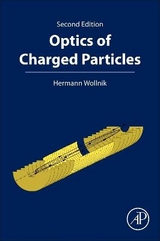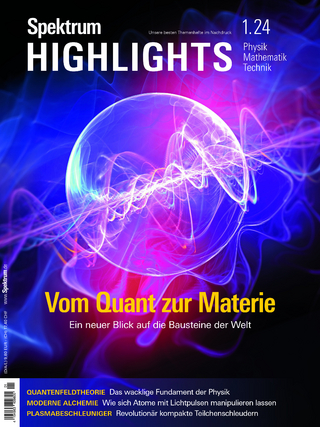
Optics of Charged Particles
Academic Press Inc (Verlag)
978-0-12-762130-2 (ISBN)
- Titel erscheint in neuer Auflage
- Artikel merken
Prof. Hermann Wollnik’s work has taken him around the world and includes collaborations with the European Space Agency, the GSI research center in Darmstadt, Germany or with CERN in Geneva, Switzerland, with the Los Alamos and Oak Ridge National Laboratories in the United States as well as with the University of Osaka, Japan. After retiring from the Justus Liebig University in Giessen, Germany in 2001, he took up new collaborations with the New Mexico State University in Las Cruces, NM, United States and the GSFC of the NASA in Baltimore, MD, United States as well as with the KEK/RIKEN Research Institute in Tokyo, Japan. Prof. Wollnik’s main scientific work has concentrated on mass determinations and, thus, nuclear binding energies of isotopes of short-lived heavy and super heavy elements as well as on the identification of organic molecules on the earth and space objects as for instance on a comet head in the ROSETTA space mission. Among many different ideas were new proposals and designs of energy-isochronous time-of-flight mass spectrographs, for high- and low-energy ions, the developments of which he started in the mid-1970s.
Preface1 Gaussian Optics and Transfer Matrices 1.1 Method of Transfer Matrices 1.2 Transport through an Optical System of One Thin Lens 1.3 Transport through a General Optical System 1.4 Examples for the Use of Transfer Matrices References2 General Relations for the Motion of Charged Particles in Electromagnetic Fields 2.1 Energy, Velocity, and Mass of Accelerated Particles 2.2 Forces on Charged Particles in Magnetic and Electrostatic Fields 2.3 Description of a Chromatic Particle Bundle 2.4 Refractive Index of the Electromagnetic Field 2.5 Euler-Lagrange Equations Appendix References3 Quadrupole Lenses 3.1 Particle Trajectories in Quadrupole Lenses 3.2 Design of Quadrupole Multiplets 3.3 Properties of Thin-Lens Quadrupole Multiplets 3.4 How to Calculate Quadrupole Multiplets Numerically Appendix: Potential Distribution Between Hyperbolic Electrodes References4 Sector Field Lenses 4.1 Homogeneous Magnetic Sector Fields 4.2 Inhomogeneous Magnetic Sector Fields Formed by Inclined Planar Pole Faces (Wedge Magnets) 4.3 Radially Inhomogeneous Sector Fields Formed by Conical Pole Faces or Toroidal Electrodes 4.4 Particle Flight Times in Radially Inhomogeneous Sector Fields, Quadrupoles, and Field-Free Regions Appendix References5 Charged Particle Beams and Phase Space 5.1 Liouville's Theorem and First-Order Transfer Matrices 5.2 Phase-Space Areas of Particle Beams Passing through Optical Systems 5.3 Beam Envelopes 5.4 Positions and Sizes of Envelope Minima 5.5 A Minimal Size Beam Envelope at a Postulated Location 5.6 Liouville's Theorem and Its Application to Wide-Angle Beams 5.7 Beams with Space Charge References6 Particle Beams in Periodic Structures 6.1 Single-Particle Trajectories and Beam Envelopes 6.2 Rings of Unit Cells References7 Fringing Fields 7.1 Particle Trajectories in Fringing Fields of Dipole Magnets 7.2 Particle Trajectories in Fringing Fields of Electrostatic Deflectors 7.3 Particle Trajectories in Fringing Fields of Quadrupole Lenses References8 Image Aberrations 8.1 Systematics of Image Aberrations 8.2 Origin of Image Aberrations 8.3 Relations Between Coefficients of Equation (8.2) Due to the Condition of Symplecticity 8.4 Image Aberations of nth Order Appendix: Coefficients of Image Aberrations of nth Order References9 Design of Particle Spectrometers and Beam Guide Lines 9.1 Dispersion and Resolving Power of Multifield Particle Spectrometers 9.2 An Optical Qx Value for Particle Spectrometers 9.3 A Q1 Value for Time-of-Flight Particle Spectrometers 9.4 Correction of Image Aberrations ReferencesIndex
| Erscheint lt. Verlag | 1.3.2010 |
|---|---|
| Verlagsort | San Diego |
| Sprache | englisch |
| Gewicht | 580 g |
| Themenwelt | Naturwissenschaften ► Physik / Astronomie ► Hochenergiephysik / Teilchenphysik |
| ISBN-10 | 0-12-762130-X / 012762130X |
| ISBN-13 | 978-0-12-762130-2 / 9780127621302 |
| Zustand | Neuware |
| Informationen gemäß Produktsicherheitsverordnung (GPSR) | |
| Haben Sie eine Frage zum Produkt? |
aus dem Bereich



